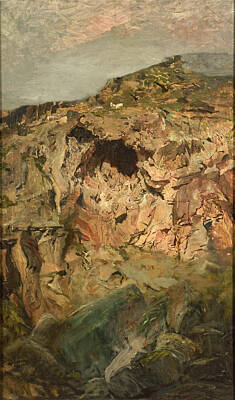Petrus van der Velden
Petrus van der Velden (5 May 1837 – 11 November 1913), who is also known as Paulus van der Velden was a New Zealand artist of Dutch descent. Van der Velden was born in Rotterdam, the Netherlands and died in Auckland, New Zealand, 11 Nov 1913. Much of his career was spent in Christchurch, New Zealand.
The Dutch Funeral, 1872
Biography
Originally he trained as a lithographer and ran a lithographic printing works in Rotterdam circa 1858–67, and then went on to study at the academies in Rotterdam and Berlin. He registered at the Academy of Art, Rotterdam in 1868. After a stay on the island of Marken (1871–73) he lived in or near The Hague until 1888 and was part of the Hague School in artistic and stylistic origins. During this period he painted mainly genre scenes such as The Dutch Funeral (1872; Christchurch, NZ, McDougall A.G.) and the Old Cellist (1887; The Hague, Gemeentemus.); he also produced some landscapes, for example Snow on the Sand Dunes (1889–90; Wellington, Mus. NZ, Te Papa Tongarewa). His work of this period displays a tension between Naturalism and Romantic Realism in the style of Jozef Israëls.
Waterfall in the Otira (aka Mountain Stream), 1891
Snow on the Sand Dunes, 1880
In 1890, also the year in which van Gogh died, van der Velden emigrated to New Zealand with his wife and children (one daughter and two sons), aged 53. He arrived in Christchurch, where he stayed until 1898. It was during the 1890s that van der Velden discovered Otira Gorge on the West Coast, which provided him with his most successful and enduring subject, one that contributed to the revolution of New Zealand painting. The first trip took place in 1891 and the product was Waterfall in the Otira (aka Mountain Stream) (1891; Dunedin, NZ, Pub. A.G.). Local legend has it that when van der Velden visited Otira he patiently waited for the weather's most dramatic moments. Only when thunder, rain and wind were in full chaotic swing would he race up to the Gorge with paints in hand; when sun and calm prevailed he would sleep on the grass in front of the Otira hotel. The recognition of this work and van der Velden's accomplishments is evident when he exhibited with the Otago Art Society in 1892. His Waterfall was judged "by an almost unanimous verdict....the great feature of this year's exhibition."
By 1894 van der Velden had taken on students, among whom were Sydney Lough Thompson, Robert Procter, Cecil Kelly, Elizabeth Kelly, Leonard Booth, and Raymond McIntyre. His teaching method placed emphasis on acquiring an intimate acquaintance with the subject by doing a great many drawings and studies. In 1897 he left New Zealand taking his family to Sydney in April. In a letter written before their departure he is very bitter, talking of his "financial strife in Durham Street" and terming New Zealand the " land of liars". Van der Velden stayed in Australia for five years during which time his wife Sophia died (1 May 1899) and his daughter Riek had to return to New Zealand for her health in 1900. The next year van der Velden suffered from a "rupture of a blood vessel of the stomach" and was in a convalescent home. A letter from his son Willem records van der Velden's time in Australia so far: "An account of our trials and struggles for existence in the 'Sunny New South Wales' would seem incredible. And evidence is not wanting pointing to the existence of a plot to keep my Father down and crush him out of Sydney. So far it has been very successful." It seems that van der Velden had failed to find the patronage he sought and the other artists, themselves struggling, resented the appearance of this new intruder.
Sometime late 1903 or early 1904 he returned to Wellington, bringing with him a young Australian woman, Australia Wahlberg, whom he married at the Wellington Registry office on 4 February 1904. A son Noel Van der Velden was born in 1906 but died aged 24 days and a daughter named Melba Van der Velden was born in 1909. Van der Velden initially settled in Wellington, but planned to move to Auckland, where he died of a heart attack in 1913.
Many of his works are in public galleries in New Zealand and the Netherlands.[1]
Works
The Hermit of Island Bay, circa 1904-12. currently in the collection of Te Papa[2]
Gallery
Works by Petrus Van der Velden
Rock study, circa 1890 (Te Papa, Wellington)
Mountain stream, Otira Gorge, circa 1893 (Te Papa, Wellington)
Tree study, 1893-1898 (Te Papa, Wellington)
Storm at Wellington Heads, circa 1908 (Te Papa, Wellington)
References
Works by Petrus Van der Velden at the Museum of New Zealand Te Papa Tongarewa
http://collections.tepapa.govt.nz/object/41290
Biography in 1966 Encyclopaedia of New Zealand
Biography in Oxford Art Online
Brown, Gordon H. and Hamish Keith. An Introduction to New Zealand Painting 1839–1967. Auckland: Collins, 1969.
Wilson, Rodney T. L. Petrus van der Velden: 1837–1913. Wellington: Reed, 1979.
----
Fine Art Prints | Greeting Cards | Phone Cases | Lifestyle | Face Masks | Men's , Women' Apparel | Home Decor | jigsaw puzzles | Notebooks | Tapestries | ...
----
Artist
A - B - C - D - E - F - G - H - I - J - K - L - M -
N - O - P - Q - R - S - T - U - V - W - X - Y - Z
Retrieved from "http://en.wikipedia.org/"
All text is available under the terms of the GNU Free Documentation License






